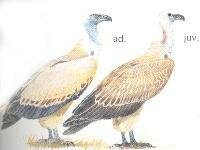Home > Don't just hike > Birds
Soar with grace ...
Cape Vulture


Look and wonder at these majestic birds soaring high in the sky.

Breeding cyle of the Cape Vulture (Gyps coprotheres)
The Cape Vulture needs cliffs to breed on and this is why the Cape Vulture relies on the Olifants Nek cliffs as a breeding site. The other nesting site to be found on the Magaliesberg range is at Skeerpoort near Hartebeespoort Dam.
The collecting of nesting material starts around April/May and copulation also takes place at this time and can continue right through until mid December. Eggs are laid from April through July with May being the peak month. Normally only one egg is laid, occasionally two. Both sexes incubate and change-overs occur between 09h55 and 16h22. The sitting bird occasionally stands up and changes positions and rolls the egg about before settling down again. The nests are never left for more than seven minutes. During this time of unattendance, the nesting bird will fly off, preen itself and occasionally collect nesting material. The incubation period varies between 56 and 59 days.
The new hatched chick is covered in white down over its pink skin, and its eyes are black. After four weeks, it will be clad in a thick second coat of white down and by six weeks, the main dorsal feather tracts emerge through the down and a week later the ventral tracts appear. By ten weeks, the nestling appears almost fully feathered.
Both parents take turns in tending and feeding the chick throughout the nesting period. Small young are closely brooded and are fed by mouth-to-mouth regurgitation right through until they are fully grown. An adult bird will be on the nest guarding the chick until it is at least 90 days old. Bones or substantial artifacts are brought to the nest throughout the nestling period for the nestling to eat.
The nesting time is approximately 140 days. When the young bird starts to fly, it is clumsy and has difficulty in alighting. The first birds start flying around mid November and go through to December.
Vulture restaurants
The vulture colonies are part of the Magaliesberg’s very special attraction but outside nature reserves, vultures in South Africa lead an existence that is more or less precarious.
Like all animals, vultures have to eat – but like few other animals – vultures only eat creatures that are already dead. So when the indigenous animals of the plains were replaced with well-managed herds of livestock, a problem developed. Few carcasses became available as keepers of livestock preferred to incinerate or bury their dead animals to avoid the spread of disease.
Large predators such as lion, cheetah and spotted hyena also vanished, succumbing to the ruthless crack of rifles and the bitter taste of strychnine. No more predators, no more carcasses, no more bone fragments for the fast growing Cape griffon nestlings.
The results were disastrous for the Cape Vulture in particular. Nestlings died from severe skeletal deformities as their supply of calcium dried up, while their parents had to forage further and further afield to keep the crops of the family full.
A bright light lit up somewhere a couple of decades ago when a bakkie stopped in the veldt. People pulled a dead cow off the back and drove off, full of hope and aspiration. Cape griffons descended on the cow as if to pay homage to this sacrifice.
Later, when the bare bones were left in the sun, the same people volunteered to do some bone bashing. The cape griffons returned to collect bone chips for their young and a dreadful cycle of calcium-deficiency deaths was broken.
It took some years for the vulture restaurant idea to take off, but in the mid 90’s South Africa could truly be considered the world’s leader in vulture restaurant technology.
Farmers, conservationists, provincial authorities, National Parks Board and private game lodges turned the vulture restaurant philosophy into an important conservation tool. Long gone are the days when vulture restaurants were simply serving the scavengers a meal. The modern concept involves the monitoring of marked birds and keeping vultures away from poisoned food – and, very importantly it involved the public.
The Vulture Study Group was inundated with enquiries from people who wanted to watch the vultures feeding, and hides were built to accommodation them.
There is fare more to a vulture restaurant than meets the eye (or nose!!). Vultures get access to ample, poison-free food, researchers get the opportunity to observe their study specimens, the public are given a change to enjoy the ‘clowns of the veld at their dinner table’, landowners have a means of getting rid of dead animals, vulture restauranteurs generate extra income from the visitors, and the whole exercise generates a very positive feeling towards the birds among the public in general.
If vulture restaurants continue as the success story they have become, things can only become better for the ‘scavengers of the skies’.


